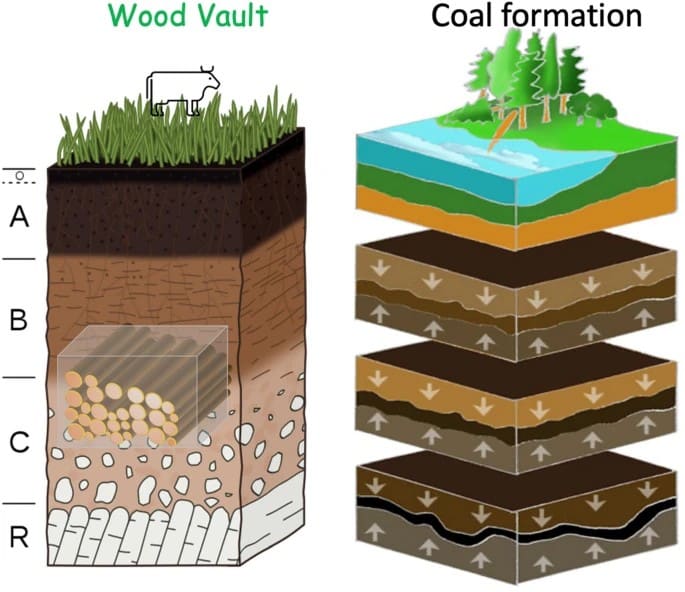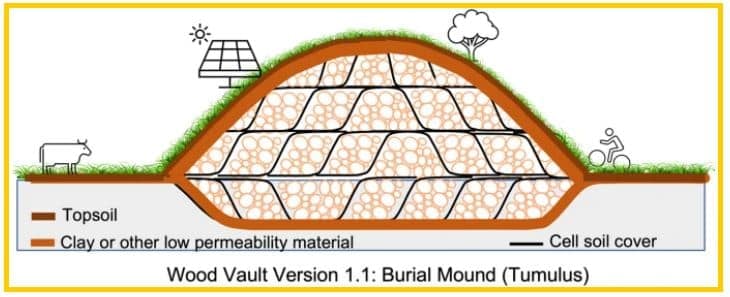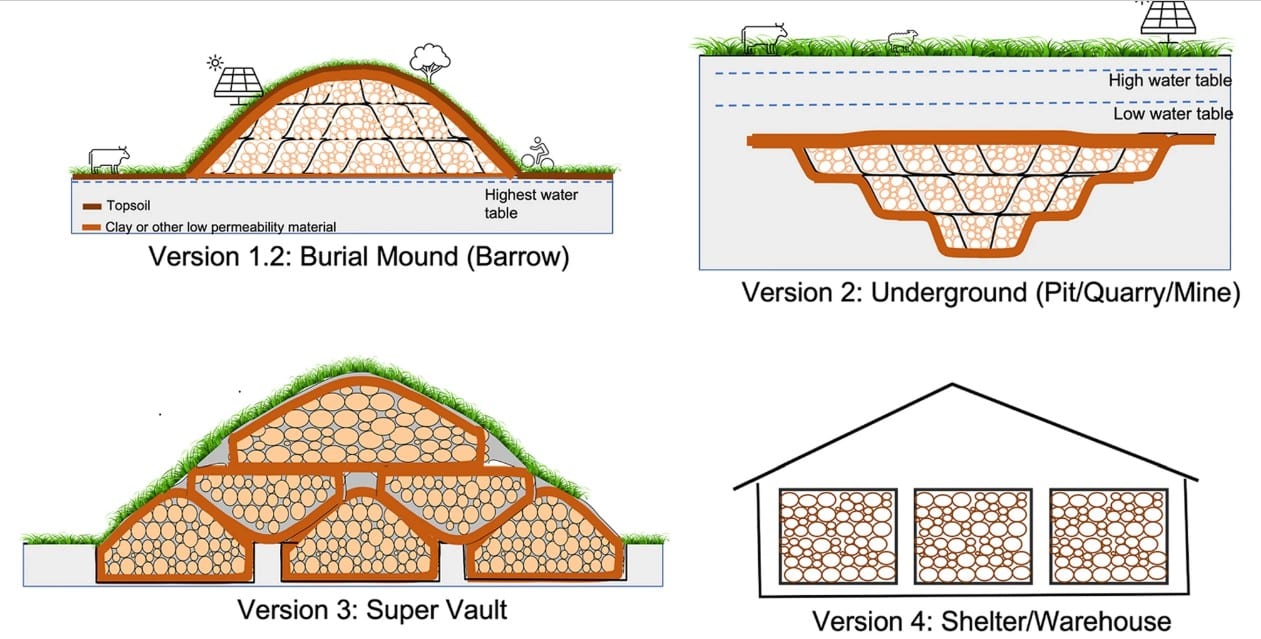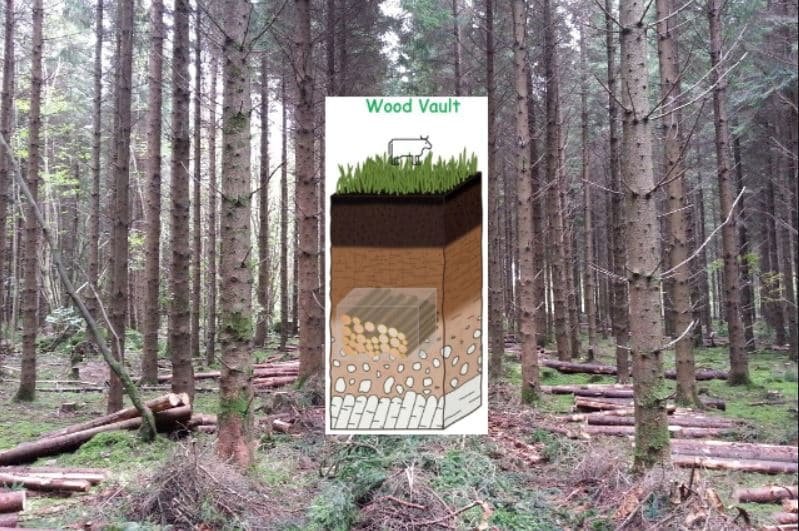Removing carbon dioxide through dead trees and storing it for thousands of years underground is a mission that seems to attract nobody. But a California startup, Kodama Systems, is persistent enough to take on the challenge.
After all, ensuring that dead trees keep carbon out of the atmosphere for millenia and bury them below the ground is one novel way to help mitigate climate change. And a novel concept also came out of that – wood vault – a carbon storage facility that you probably haven’t heard of.
This article will talk about the wood vault, its key factors, and what makes this biomass carbon storage challenging.
Carbon Removal and Storage in the Woods
Several researchers and startups have been looking into the potential of wood to lock up carbon in its biomass. It can be either by burying it or storing remains of dead trees to slow down decomposition. That will also limit the release of carbon back into the atmosphere.
Trees are a natural carbon storage facility, capturing huge amounts of CO2. But once they die and rot, that carbon they’re holding on their biomass goes back to the air.
That’s why the idea of storing dead trees underground pops up to prevent re-emissions. If this concept works as planned, it can offer a cheap way to help lock in carbon and keep global temperatures at bay.
In a broader term, wood harvesting and storage is a hybrid Nature-Engineering combination method to combat climate change. It refers to harvesting wood sustainably and storing it for carbon sequestration.
To date, this carbon storage technology has only been purposefully tested in small-scale demonstration projects. But Kodama aims to show that it’s possible to do it on a large-scale.
Kodama Systems is a forest management firm headquartered in the Sierra Nevada foothills town of Sonora. It was founded in summer last year and has been operating stealthily since then.
The company has raised over $6 million from Breakthrough Energy Ventures, Congruent Ventures, and other investors.
Moreover, Stripe also provided a $250,000 research grant to the company and its research partner, the Yale Carbon Containment Lab. That funding is part of Stripe’s broader commitment to carbon removal.
The grant will support a pilot effort to bury waste biomass harvested from California forests in the Nevada desert. It will also back the study that will determine how well the wood vault method avoids the emissions of GHGs.
Others refer to this carbon storage as “biomass burial”. It has the potential to be a cost-efficient, large-scale option for carbon removal and storage.
But until it’s been studied more closely and demonstrated to work on large scales, it remains to be seen… how much and how long.
How much carbon can the wood vault system store? How much will this carbon storage tech cost? And how long can it keep carbon out of the air?
Let’s break down each question and address them one-by-one… starting off with the concept of wood vault.
What is a Wood Vault?
It may sound like a storage where you can keep your personal things away but it’s much different. But it’s a storage facility though.
While it works pretty well as a vault, where things are kept, wood vault refers to an especially engineered structure or facility that keeps wood biomass from decomposing or rotting. Its purpose is for semi-permanent wood storage as carbon sequestration.
Wood vaults come in various types and the major one uses soil. Other types include the ones in water and dry/cold conditions.
The illustration below from Zeng and Hausmann 2022 study shows the wood vault in a standard soil profile. Its key factors are the following:
- Woody biomass is buried deep underground, away from the biologically active topsoil.
- The wood is buried in a manner that ensures anaerobic (active in the absence of oxygen) condition. Or it’s stored in dry or cold conditions that prevent decomposition for durable carbon storage.
- The biomass burial process is similar to the first step of coal formation as shown below.
Compared to natural coal formation where plants are buried in favorable conditions at a slow rate, the rate of wood vault burial is faster due to human intervention through wood harvesting and carbon storage construction.
Biomass burial is the exact opposite of dig-and-burn that hastens fossil fuel oxidation. As such, it’s a natural way to somehow undo the carbon emissions from burning fossil fuels.
The Wood Vault in a standard soil profile:

Wood biomass is buried in the subsoil, in B-horizon or lower horizon as shown above. The dead timber is then capped with low permeable material such as clay to achieve anaerobic condition. But if the subsoil provides enough low permeability, there’s no need for capping.
Upon proper enclosure, the original topsoil is backfilled for vegetation or other use.
The transparent enclosure in the image is for visual purposes only. The actual material used varies depending on the specific version or type of wood vault used.
Here’s one version of the vault, then followed by other different versions applicable.

Version 1.1 above is a basic wood vault unit partially above ground and partially underground. It’s divided into cells, with each cell sealed once filled. After the top is finally enclosed, the original topsoil is placed back (dark brown) for grass to grow. Reddish brown represents clay or clay-like liner.
The area can then be used for purposes such as cropland, park, solar farm, or grazing land.

Burying the Dead… Biomass
Wood is 50% carbon by mass. And forests are mostly trees, both living and dead.
Forest experts think that too aggressive fire suppression policies led to overgrown forests. They believe that this is increasing the risk of more damage in case wildfires happen.
Add to this the hotter and drier forest conditions due to climate change, so what you get… is more danger for a wildfire to spread. Therefore, several states decided to fund initiatives that clear out forests to lessen those dangers which include.
- Undergrowth removal
- Cutting down trees
- Controlled burns to prevent wildfires from reaching forest crowns
These efforts can produce more forest wastes. Not to mention that harvested plants and trees are often left piled up in cleared areas. Only if they’re stored safely somewhere else, but no.
The logs and other parts of a dead tree are either burned or left to rot. Unfortunately, it brings back the carbon stored in wood biomass into the atmosphere, causing more warming.
This is where Kodama’s wood vault project kicks in…
The company hopes to resolve both problems of carbon emissions and wildfires. They’re developing automated ways to thin out overcrowded forests for cheaper and faster thinning. They’ll be loading stripped limbs that are too small to sell into trucks and transport them into the wood vault.
- Kodama’s burial mound will be in the Nevada desert. It will be 7 yards high, 3 yards deep, and 58 yards long and across.
The company will cover the biomass with a geotextile liner, bury it under soil, with a layer of native vegetation on topsoil. The region has dry conditions – perfect for a storage facility that repels decomposers from rotting the buried biomass.
So, what about the costs and storage durability?
Under ideal conditions, the carbon in the wood stays there for thousands of years.
But the Kodama team plans to create smaller side vaults designed in various ways. They’ll continue to monitor the vaults and compare their performance when it comes to leakage and decomposition rates. From that observed data, the company will be able to produce long-term carbon storage estimates and other relevant findings.
The Challenge: Burial Cost
A research paper found out that storing wood biomass can remove billions of tons of carbon each year at a cost of less than $100/ton. Yet, there are still many areas left unknown.
Add to that, local residents and environmental campaigners are opposing forest thinning. That’s for the reason that doing it is laborious and costly. One has to pay for the workers collecting the wood biomass and for those digging the holes of the wood vault.
Plus, the cost of a Wood Vault facility also includes several other things such as land purchase, construction, and operation. Work and quality control are also a large budget item. While transport of wood from source to the facility is estimated at a rate of $5/ton for a 25-mile haul, according to Zeng and Hausmann.
In total, the authors’ estimated cost for the 1 ha wood vault unit will be $1.2–1.8 million for storing 100,000 tCO2 in a year, at a price of $12–18/tCO2 sequestered.
Estimated Cost of Building a Wood Vault (1 ha)

Moreover, the entire process needs a lot of energy.
In effect, the emissions caused by removing, transporting, and burying wood have to be tallied and counted against the total carbon stored.
Interestingly, there’s about 56 million “bone dry” tons of waste biomass produced every year in California alone. These are wastes from logging, agriculture, fire prevention activities, and other activities.
While the opportunity is high, there’s some risks involved, too. It can create unintended incentives to remove more trees or agricultural wastes than necessary. After all, removing biomass also decreases the levels of nutrients that plants and trees get from decaying matter.
But as more and more companies like Kodama are seeking out to take on carbon removal solutions, the demand will also grow.
Another positive aspect of wood vaults is the value for later land use. Unlike a foul-smelling landfill for municipal wastes and chemicals, a wood vault is clean, safe, and stable.
And the best part?
Companies can earn revenue not just from forest thinning work, but also from carbon credits generated by wood vaults. For each tonne of carbon sequestered by the wood vault, each credit is also generated.

